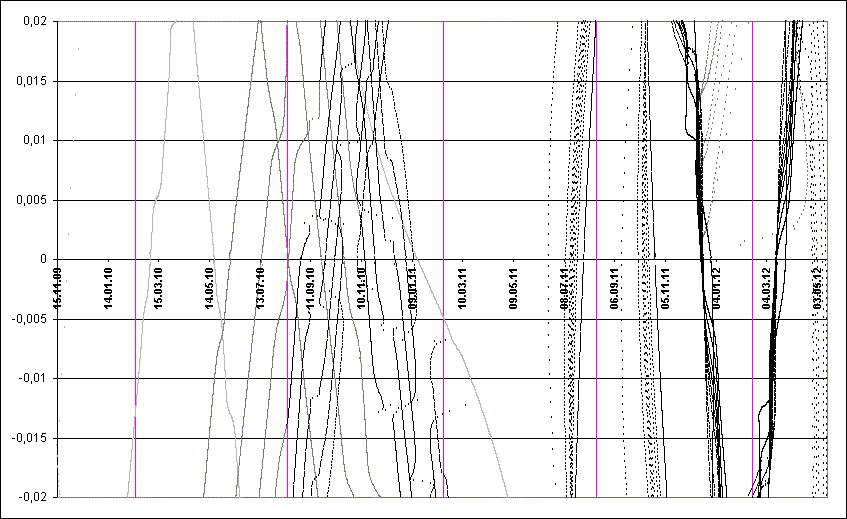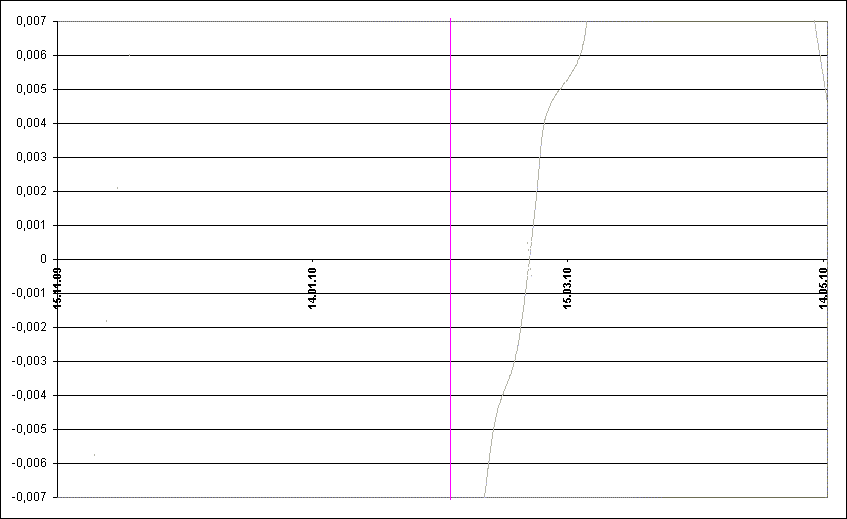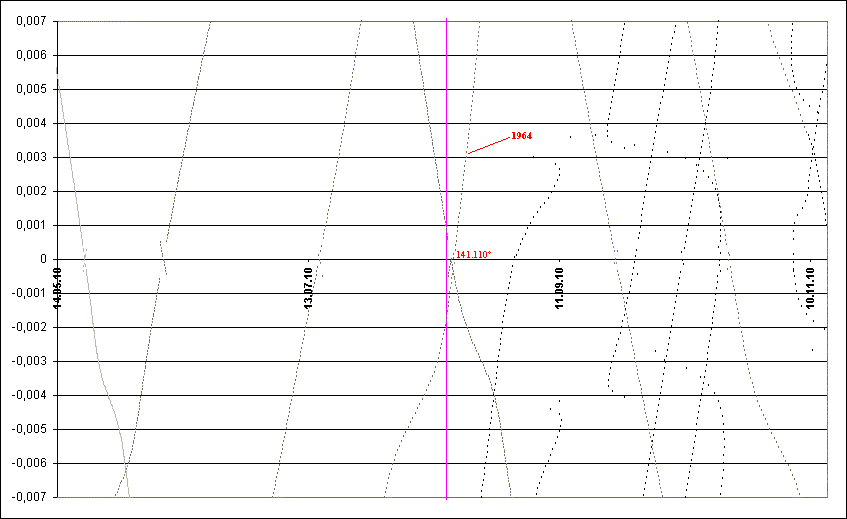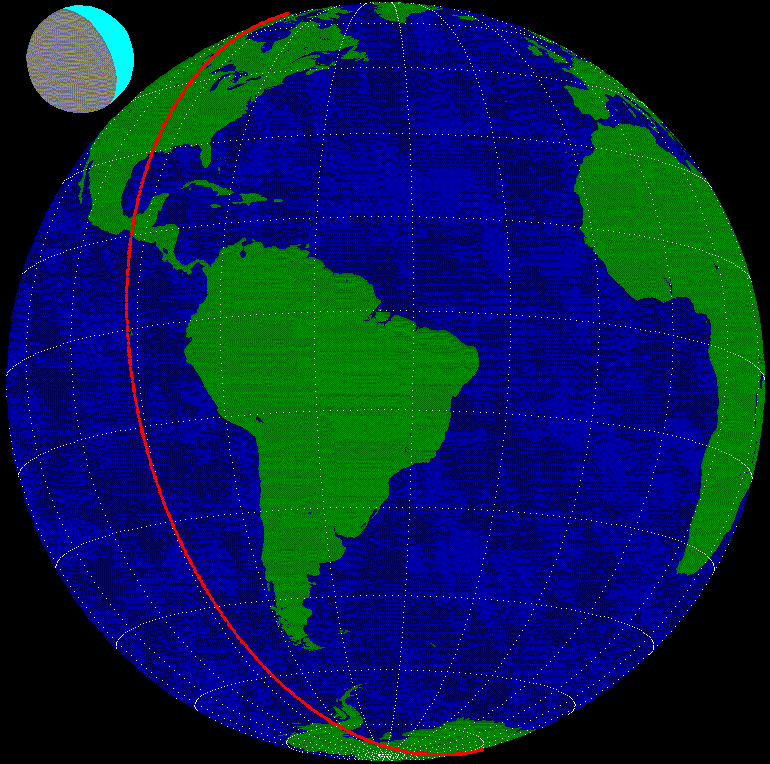45P-ids 2010: prediction of activity
to the list of predictions

Fig. 1. Space-temporal projection of 45p-ids trails parts onto their minimal distance passages dirung the period 15.11.2009-15.05.2012 (correspondence between colours of the particles and their ejection velocities can be seen here).

Fig. 2. Detailed space-temporal projection of 45p-ids trails parts onto their minimal distance passages dirung the period 15.11.2009-15.05.2010 (February maximum) (correspondence between colours of the particles and their ejection velocities can be seen here).

Fig. 3. Detailed space-temporal projection of 45p-ids trails parts onto their minimal distance passages dirung the period 14.05.2010-14.11.2010 (August maximum) (correspondence between colours of the particles and their ejection velocities can be seen here).
In 2010 around August maximum of the comet 45P meteor stream we expect a vertical encounter with 1964 trail, which crosses the Earth's orbit just 2.84 days after the Earth's passage of intersection point. The parameters of encounter are the following: rD-rE_eq=-0.00037 AU, Vej=-11.12 m/s fM(fMD)=1.266, S.l.=141.110°, maximum time 14.08.2010 3:30 UT, ZHRex=20-30 meteors, high brightness, theoretical radiant: RA=325.7°, Dec=-10.8°, v=25.6 km/s.

Fig. 4. The Earth as seen from coming 45p-ids meteors (Radiant: RA=325.7°, Dec=-10.8°) during the peak from 1964 trail at 3:30 UT on 14 August 2010. Red line shows the border of hemisphere where the Moon is above horizon (it is shown with in the corner of the Fig. 4 according to its phase).
The Fig. 5 shows the map with regions where this peak from 1964 trail will be visible if occurs at given time. The most favorable conditions for visual observations will be South America - the radiant will be high in the sky for observers on the whole continent, excluding perhaps its extremely southern part. The radiant's altitude will also be sufficient in Central America, western parts of Africa and south-eastern coastal districts of North America. The Moon will have waxing crescent phase and will set down for almost every named observing places, excluding only some parts of Central and North America. 45p-ids meteors are expected to have a moderate velocity, a bit slower than, say, Geminids, but notably faster than Draconids or June Bootids.
We also have to note that earlier predictions for this case of possible 45p-ids activity were made by Sergey Shanov (Russia) and Mikiya Sato (Japan). So far our forecast confirms the results of those researches. The same time, we should note that reliability of this forecast is much lower than, say, for the Perseids of Leonids, as 1)there were no apparent cases of 45P meteor stream activity in the past so we haven't any observing data to calibrate the ZHRex estimation model; and 2)the Earth encounters the part of 1964 trail composed of particles with negative ejection velocity. For such velocities we also have a very limited observing statistics.
References
1. "Comet's dust 2.0" program by S. Shanov and S. Dubrovsky. [Used for orbital computations.]
2. Lyytinen E, van Flandern T. "Predicting the strength of Leonid outbursts", 2000, Icarus, P. 158-160.
3. Jenniskens P. Meteor showers and their parent comets, 2006, 780 p. 4. Kasuo Kinoshita, http://jcometobs.web.fc2.com/ [Orbital elements of the comet 45P\Honda-Mrkos-Pajdusakova]
We also have to note that earlier predictions for this case of possible 45p-ids activity were made by Sergey Shanov (Russia) and Mikiya Sato (Japan). So far our forecast confirms the results of those researches. The same time, we should note that reliability of this forecast is much lower than, say, for the Perseids of Leonids, as 1)there were no apparent cases of 45P meteor stream activity in the past so we haven't any observing data to calibrate the ZHRex estimation model; and 2)the Earth encounters the part of 1964 trail composed of particles with negative ejection velocity. For such velocities we also have a very limited observing statistics.
References
1. "Comet's dust 2.0" program by S. Shanov and S. Dubrovsky. [Used for orbital computations.]
2. Lyytinen E, van Flandern T. "Predicting the strength of Leonid outbursts", 2000, Icarus, P. 158-160.
3. Jenniskens P. Meteor showers and their parent comets, 2006, 780 p. 4. Kasuo Kinoshita, http://jcometobs.web.fc2.com/ [Orbital elements of the comet 45P\Honda-Mrkos-Pajdusakova]